Numerical Simulation for the Wave of the Variable Coefficient Nonlinear Schrödinger Equation Based on the Lattice Boltzmann Method
Abstract
1. Introduction
2. Basic Theory of Lattice Boltzmann Model
3. Lattice Boltzmann Model and Numerical Simulation of Variable Coefficient Nonlinear Schrödinger Equation
3.1. Variable Coefficient Nonlinear Schrödinger Equation with Perturbation Term
3.1.1. Recovery of Macroscopic Equations
3.1.2. Numerical Simulation of Wave Propagation
3.2. Variable Coefficient Fractional Order Nonlinear Schrödinger Equation
3.2.1. Recovery of Macroscopic Equation
3.2.2. Numerical Example
4. Conclusions
Author Contributions
Funding
Data Availability Statement
Conflicts of Interest
Appendix A
References
- Huang, F.T. Algorithm and Characterization of Optical Soliton Solutions for NLS Equations in Fiber Optic Communications; University of Science and Technology Beijing: Beijing, China, 2023. [Google Scholar]
- Chen, X.W. A Study of the Soliton Solution of the Schrödinger Equation with Variable Coefficients; Nanjing University of Information Engineering: Nanjing, China, 2018. [Google Scholar]
- Wen, S.T.; Manafian, J.; Sedighi, S.; Atmaca, S.P.; Gallegos, C.; Mahmoud, K.H.; Alsubaie, A.S.A. Interactions among lump optical solitons for coupled nonlinear Schrödinger equation with variable coefficient via bilinear method. Sci. Rep. 2024, 14, 19568. [Google Scholar] [CrossRef] [PubMed]
- Song, N.; Liu, R.; Guo, M.M.; Ma, W.X. Nth order generalized Darboux transformation and solitons, breathers and rogue waves in a variable-coefficient coupled nonlinear Schrödinger equation. Nonlinear Dynam. 2023, 111, 19347–19357. [Google Scholar] [CrossRef]
- Gu, Y.; Chen, B.; Ye, F.; Aminakbari, N. Soliton solutions of nonlinear Schrödinger equation with the variable coefficients under the influence of Woods–Saxon potential. Results Phys. 2022, 42, 105979. [Google Scholar] [CrossRef]
- Hong, B. Exact solutions for the conformable fractional coupled nonlinear Schrödinger equations with variable coefficients. J. Low Freq. Noise Vib. Act. Control 2023, 42, 628–641. [Google Scholar] [CrossRef]
- Yu, F.; Li, L. Soliton robustness, interaction and stability for a variable coefficients Schrödinger(VCNLS) equation with inverse scattering transformation. Chaos Soliton. Fract. 2024, 185, 115185. [Google Scholar] [CrossRef]
- Yin, H.M.; Tian, B.; Chai, J.; Liu, L.; Sun, Y. Numerical solutions of a variable-coefficient nonlinear Schrödinger equation for an inhomogeneous optical fiber. Comput. Math. Appl. 2018, 76, 1827–1836. [Google Scholar] [CrossRef]
- Tay, K.G.; Choy, Y.Y.; Tionng, W.K.; Ong, C.T. Numerical solutions of the dissipative nonlinear Schrödinger equation with variable coefficient arises in elastic tube. Dyn. Contin. Discret. Impuls. Syst. Ser. B. Appl. Algorithms 2018, 25, 53–61. [Google Scholar]
- Sun, J.; Dong, H.; Liu, M.; Fang, Y. Data-driven rogue waves solutions for the focusing and variable coefficient nonlinear Schrödinger equations via deep learning. Chaos 2024, 34, 073134. [Google Scholar] [CrossRef] [PubMed]
- Qian, Y.H.; d’Humieres, D.; Lallemand, P. Lattice BGK Models for Navier- Stokes Equations. Europhys. Lett. 1992, 17, 479–484. [Google Scholar] [CrossRef]
- Chen, S.Y.; Doolen, G.D. Lattice Boltzmann method for fluid flows. Annu. Rev. Fluid Mech. 1998, 30, 329–364. [Google Scholar] [CrossRef]
- Succi, S.; Benzi, R. Lattice Boltzmann equation for quantum mechanics. Phys. D Nonlinear Phenom. 1993, 69, 327–332. [Google Scholar] [CrossRef]
- He, Y.B.; Lin, X.Y. Numerical analysis and simulations for coupled nonlinear Schrödinger equations based on lattice Boltzmann method. Appl. Math. Lett. 2020, 106, 106391. [Google Scholar] [CrossRef]
- Shi, B.C.; Guo, Z.L. Lattice Boltzmann model for nonlinear convection-diffusion equations. Phys. Rev. E 2009, 79, 016701. [Google Scholar]
- Nie, X.B.; Doolen, G.D.; Chen, S.Y. Lattice-Boltzmann Simulations of Fluid Flows in MEMS. J. Stat. Phys. 2002, 107, 279–289. [Google Scholar] [CrossRef]
- Lallemand, P.; Luo, L.S. Lattice Boltzmann equation with Overset method for moving objects in two-dimensional flows. J. Comput. Phys. 2020, 407, 109223. [Google Scholar] [CrossRef]
- Dubois, F.; Lallemand, P.; Tekitek, M.M. On anti bounce back boundary condition for lattice Boltzmann schemes. Comput. Math. Appl. 2019, 79, 555–575. [Google Scholar] [CrossRef]
- Boghosian, B.M.; Dubois, F.; Lallemand, P. Numerical approximations of a lattice Boltzmann scheme with a family of partial differential equations. Comput. Fluids 2024, 284, 106410. [Google Scholar] [CrossRef]
- Wang, H.M. A lattice Boltzmann model for the ion- and electron-acoustic solitary waves in beam-plasma system. Appl. Math. Comput. 2016, 279, 62–75. [Google Scholar] [CrossRef]
- Shen, H. Finite difference study of Schrödinger equation with variable coefficients of fractional order. J. Ningxia Norm. Coll. 2023, 44, 27–34. [Google Scholar]

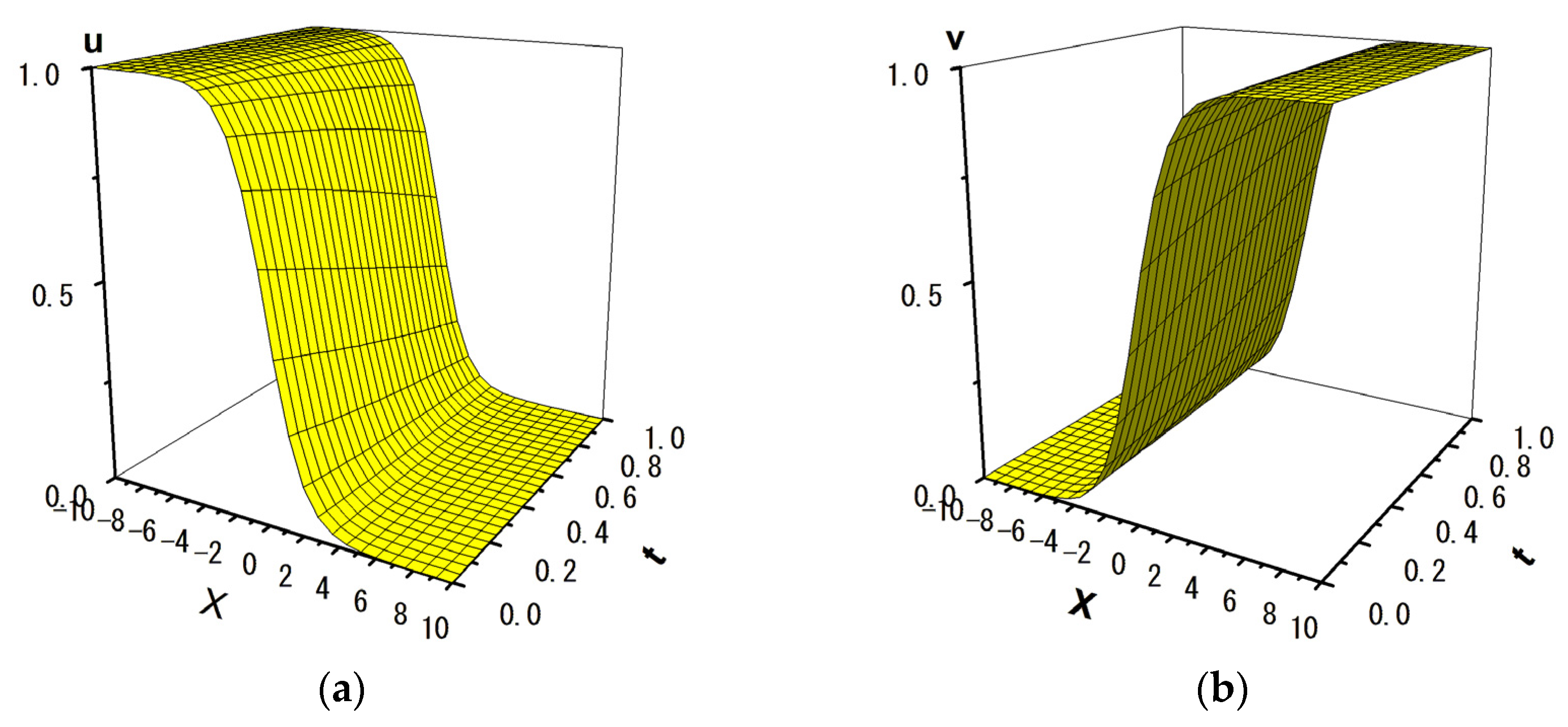
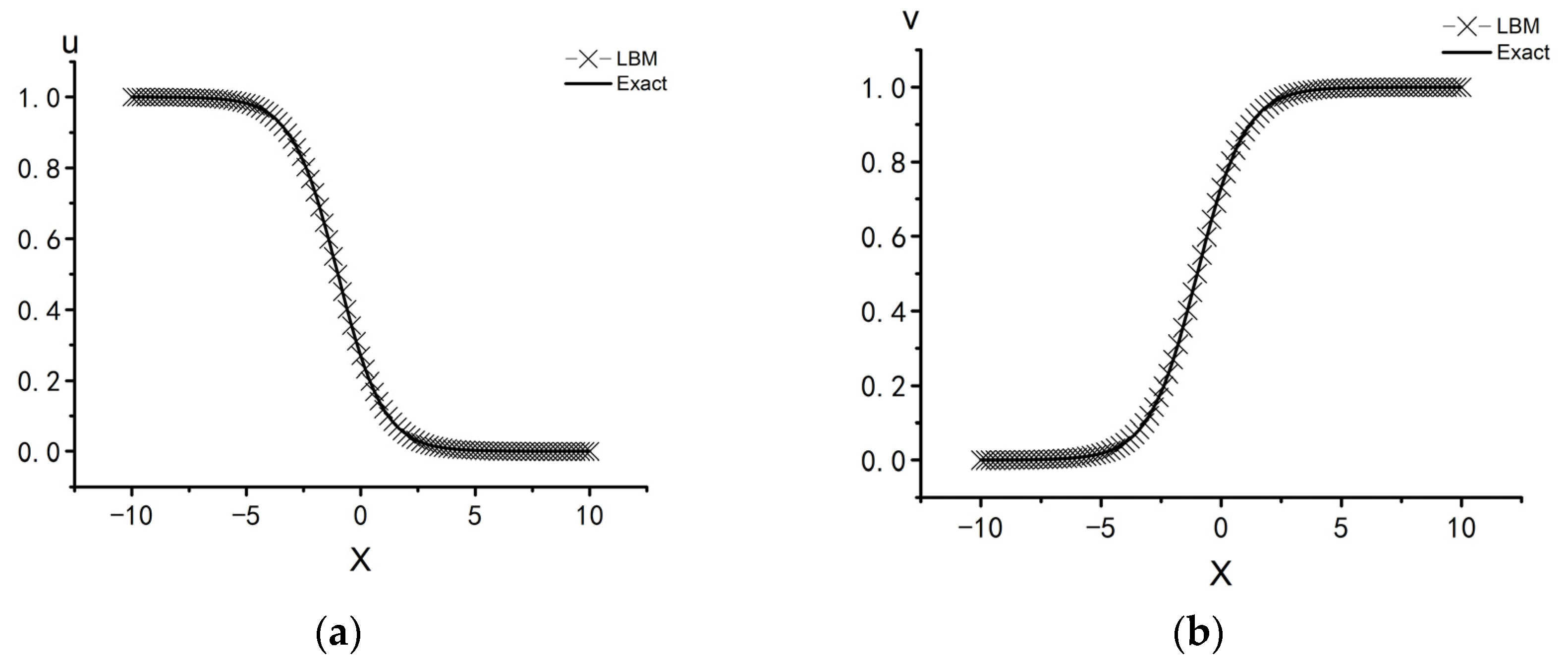
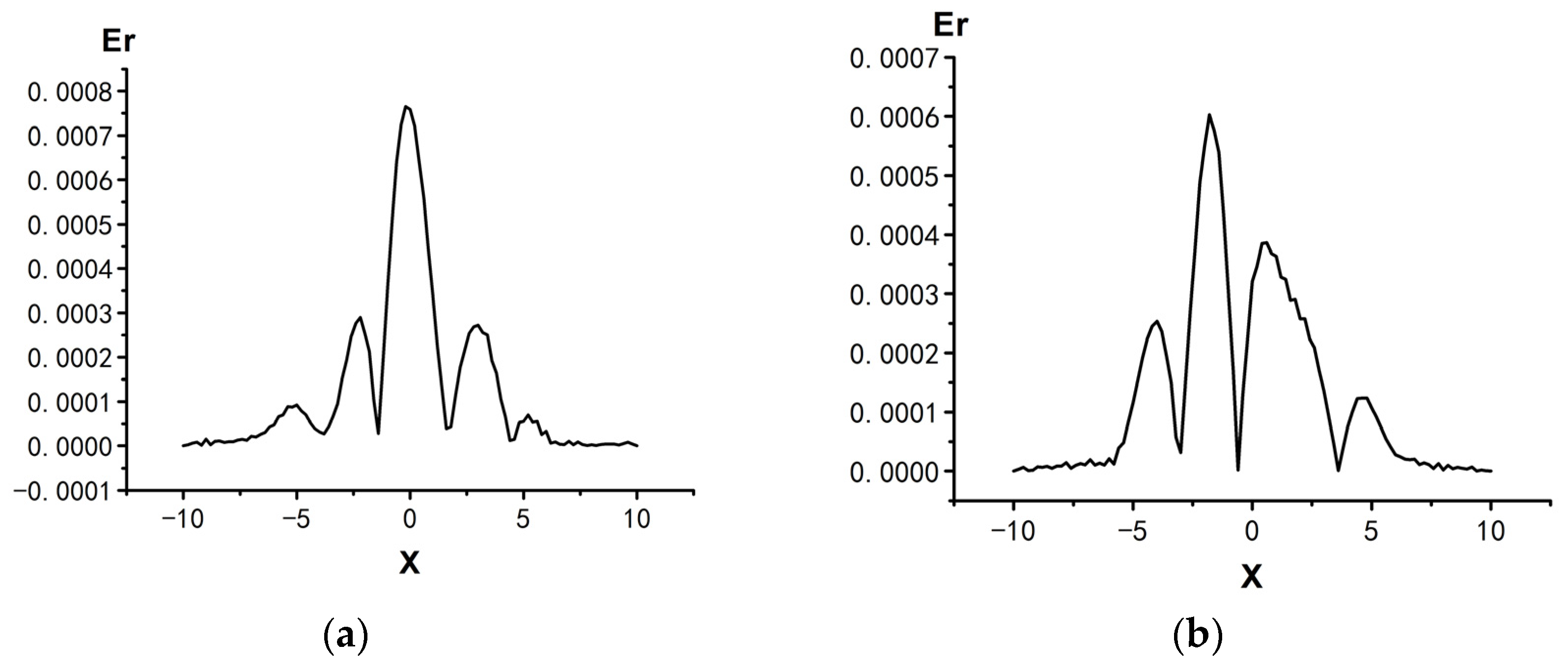
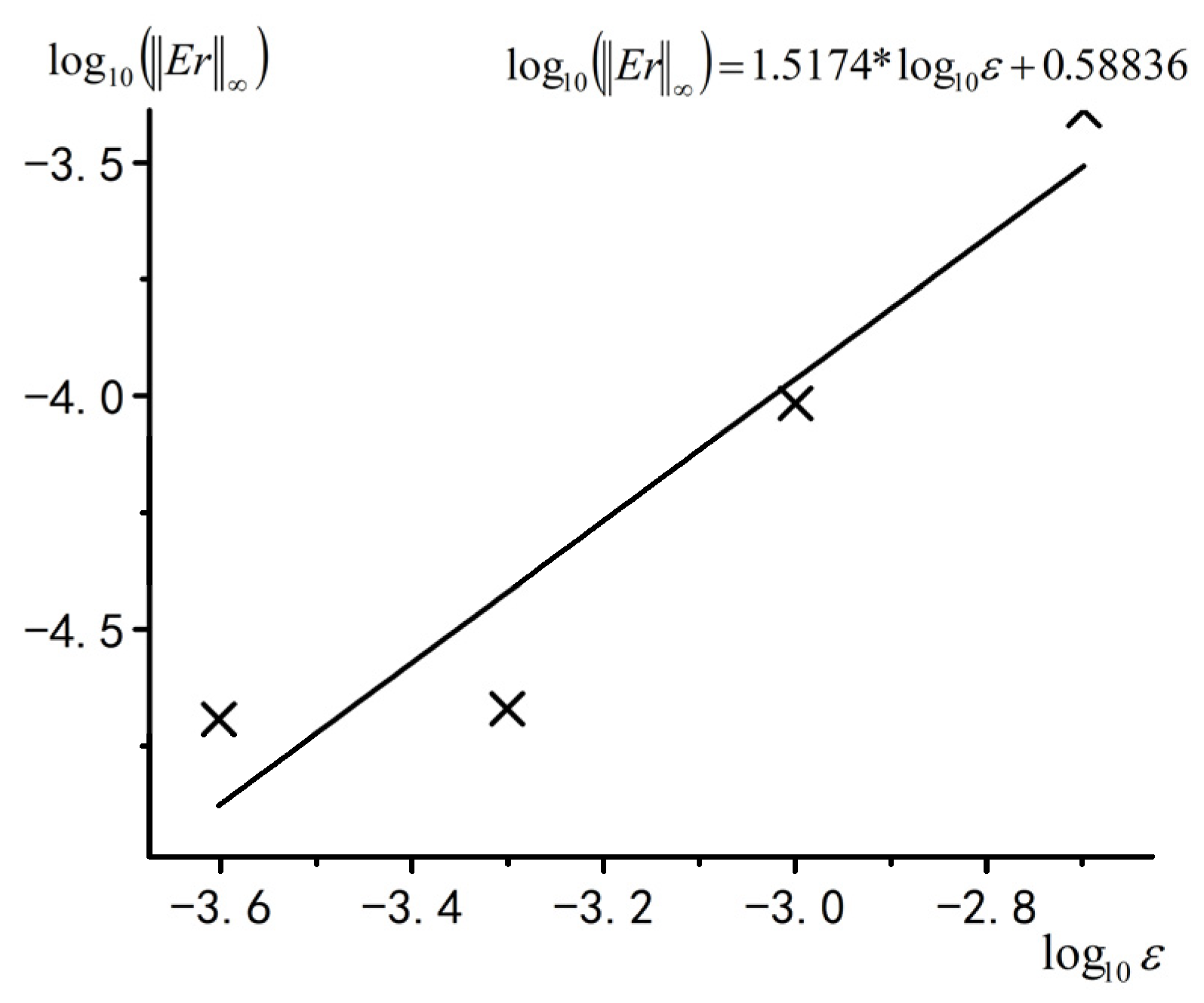
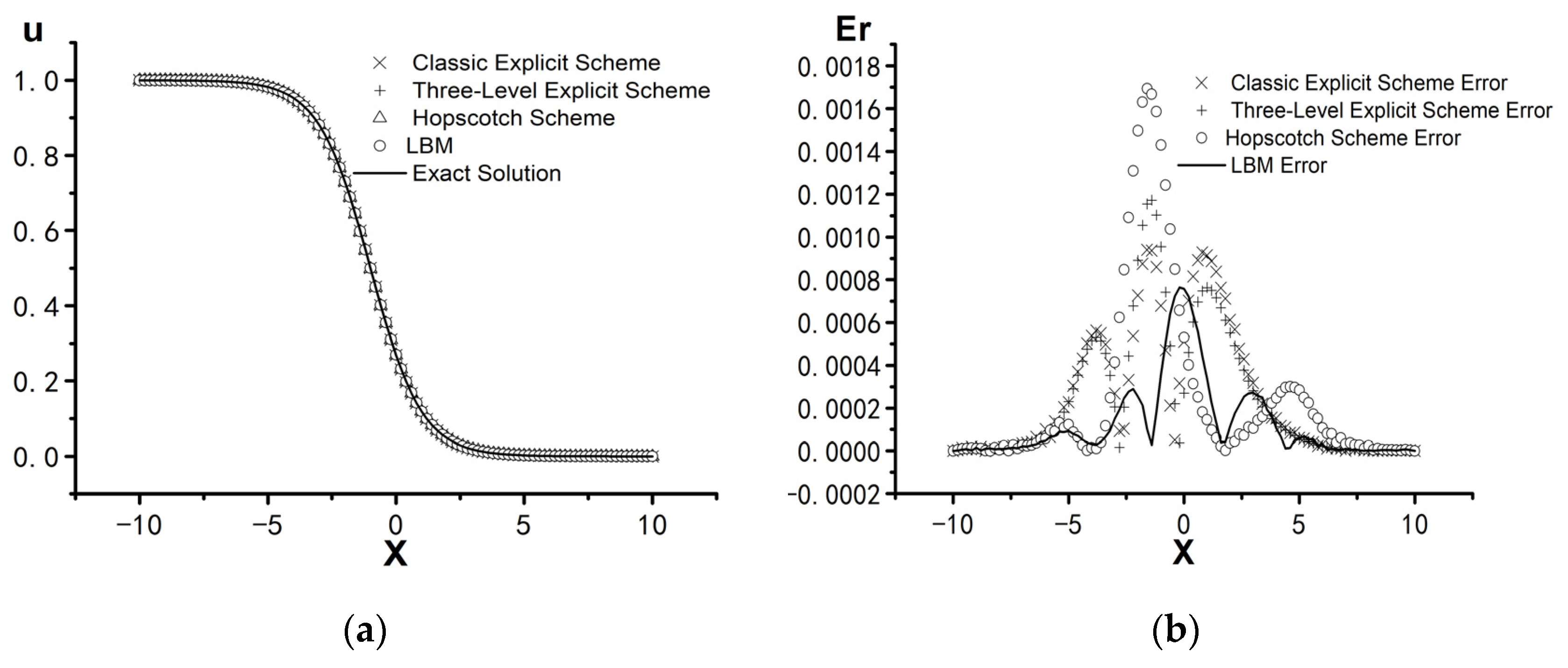
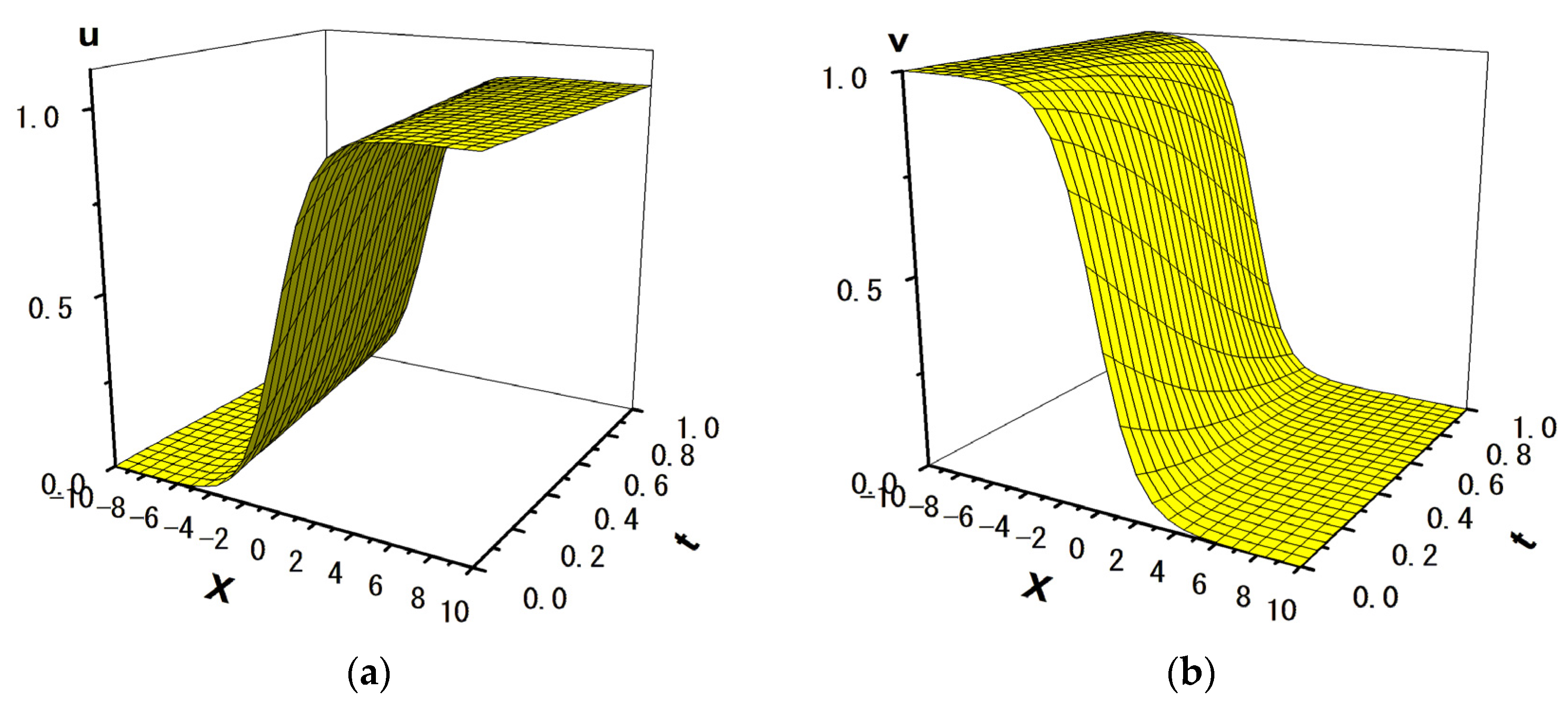


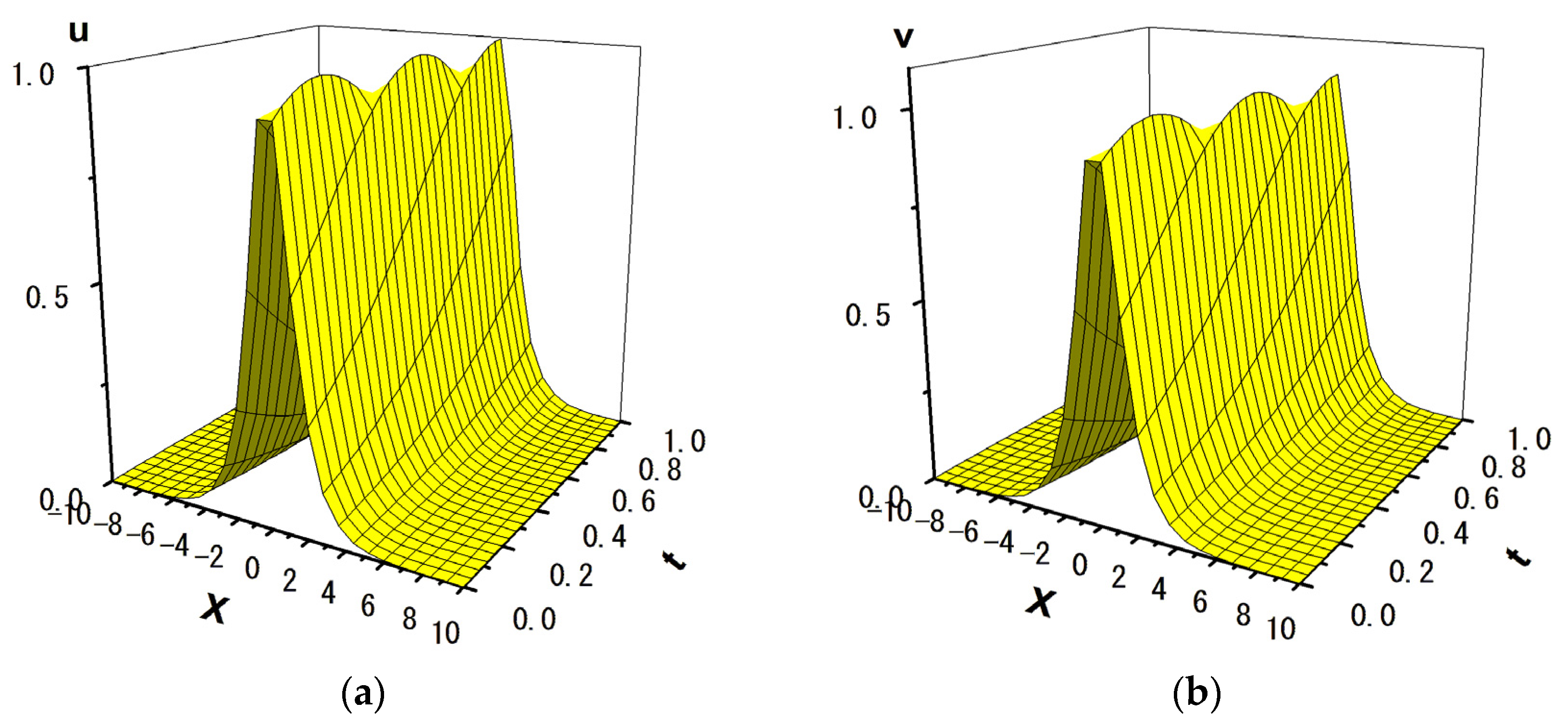

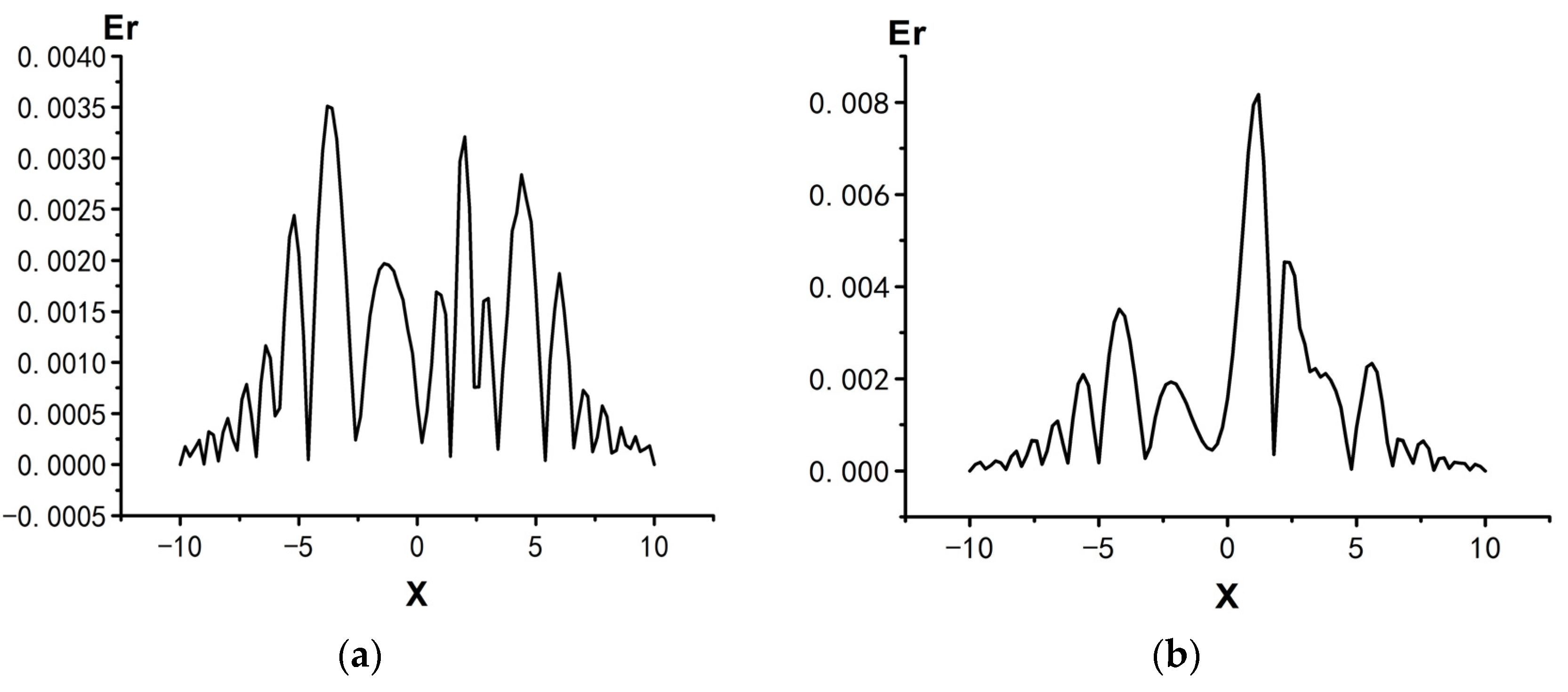


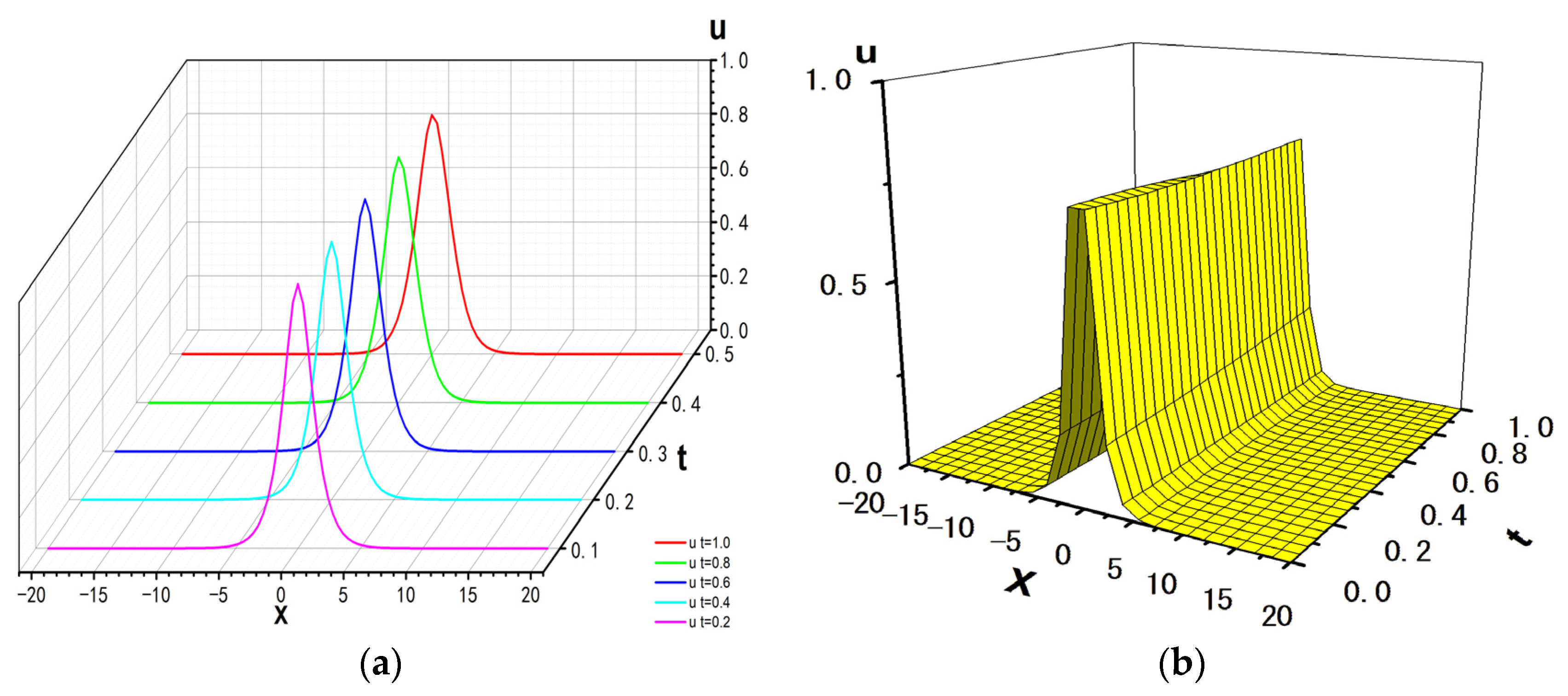

| Scheme | Time t = 0.2 | Time t = 0.4 | Time t = 0.6 | Time t = 0.8 | Time t = 1.0 | |
|---|---|---|---|---|---|---|
| Classic Explicit Scheme | 2.236962 × 10−4 | 3.646016 × 10−4 | 6.057620 × 10−4 | 8.040071 × 10−4 | 9.397864 × 10−4 | |
| CPU Time (s) | 0.094 | 0.213 | 0.259 | 0.263 | 0.310 | |
| Three-Level Explicit Scheme | 3.236234 × 10−4 | 6.066561 × 10−4 | 8.515120 × 10−4 | 1.037896 × 10−3 | 1.171649 × 10−3 | |
| CPU Time (s) | 0.133 | 0.232 | 0.268 | 0.284 | 0.311 | |
| Hopscotch Scheme | 3.938675 × 10−4 | 7.615089 × 10−4 | 1.185596 × 10−3 | 1.506567 × 10−3 | 1.693845 × 10−3 | |
| CPU Time (s) | 0.132 | 0.241 | 0.297 | 0.325 | 0.388 | |
| LBM | 1.530647 × 10−4 | 2.858341 × 10−4 | 5.033910 × 10−4 | 6.718934 × 10−4 | 7.652342 × 10−4 | |
| CPU Time (s) | 0.078 | 0.140 | 0.171 | 0.188 | 0.203 |
Disclaimer/Publisher’s Note: The statements, opinions and data contained in all publications are solely those of the individual author(s) and contributor(s) and not of MDPI and/or the editor(s). MDPI and/or the editor(s) disclaim responsibility for any injury to people or property resulting from any ideas, methods, instructions or products referred to in the content. |
© 2024 by the authors. Licensee MDPI, Basel, Switzerland. This article is an open access article distributed under the terms and conditions of the Creative Commons Attribution (CC BY) license (https://creativecommons.org/licenses/by/4.0/).
Share and Cite
Wang, H.; Chen, H.; Li, T. Numerical Simulation for the Wave of the Variable Coefficient Nonlinear Schrödinger Equation Based on the Lattice Boltzmann Method. Mathematics 2024, 12, 3807. https://doi.org/10.3390/math12233807
Wang H, Chen H, Li T. Numerical Simulation for the Wave of the Variable Coefficient Nonlinear Schrödinger Equation Based on the Lattice Boltzmann Method. Mathematics. 2024; 12(23):3807. https://doi.org/10.3390/math12233807
Chicago/Turabian StyleWang, Huimin, Hengjia Chen, and Ting Li. 2024. "Numerical Simulation for the Wave of the Variable Coefficient Nonlinear Schrödinger Equation Based on the Lattice Boltzmann Method" Mathematics 12, no. 23: 3807. https://doi.org/10.3390/math12233807
APA StyleWang, H., Chen, H., & Li, T. (2024). Numerical Simulation for the Wave of the Variable Coefficient Nonlinear Schrödinger Equation Based on the Lattice Boltzmann Method. Mathematics, 12(23), 3807. https://doi.org/10.3390/math12233807





